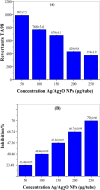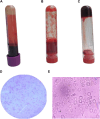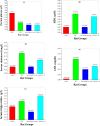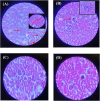Antimutagenic and anticoagulant therapeutic effects of Ag/Ag2O nanoparticles from Olea europaea leaf extract: mitigating metribuzin-induced hepato-and nephrotoxicity
- PMID: 39508051
- PMCID: PMC11538059
- DOI: 10.3389/fphar.2024.1485525
Antimutagenic and anticoagulant therapeutic effects of Ag/Ag2O nanoparticles from Olea europaea leaf extract: mitigating metribuzin-induced hepato-and nephrotoxicity
Abstract
Background: Silver nanoparticles (Ag/Ag₂O NPs) have garnered attention for their potent antioxidant, antimicrobial, and anti-inflammatory properties, showing promise for therapeutic applications, particularly in mitigating chemical-induced toxicity.
Objective: This study aimed to synthesize Ag/Ag₂O NPs using Olea europaea (olive) leaf extract as a green, eco-friendly reducing agent and evaluate their protective effects against metribuzin-induced toxicity in Wistar rats, focusing on oxidative stress, hematological parameters, and lipid profiles, with specific dose optimization.
Methodology: Ag/Ag₂O NPs were synthesized using Olea europaea leaf extract, and their properties were confirmed via XRD, FTIR, SEM, EDS, and UV-visible spectroscopy. Wistar rats exposed to metribuzin (110 mg/kg/day) were treated with two doses of Ag/Ag₂O NPs (0.062 mg/kg and 0.125 mg/kg). Hematological and biochemical markers were assessed to evaluate the NPs' protective effects.
Results: Physicochemical characterization confirmed the successful formation of Ag/Ag₂O NPs loaded with phytochemicals, exhibiting crystallite sizes of 23 nm and 19 nm, a particle size of 25 nm, and significant peaks in XRD, FTIR, and UV-Vis spectra indicating the formation of Ag/Ag₂O. Metribuzin exposure led to significant hematological disruptions (elevated WBC, reduced RBC and hemoglobin) and worsened lipid profiles (increased cholesterol, LDL, and triglycerides). The lower NP dose (0.062 mg/kg) improved WBC, RBC, hemoglobin, and platelet counts, normalized lipid levels, and positively influenced biochemical markers such as serum creatinine and uric acid. In contrast, the higher NP dose (0.125 mg/kg) showed mixed results, with some improvements but an increase in triglycerides and continued elevation of ASAT and ALAT enzyme levels.
Conclusion: Ag/Ag₂O NPs synthesized via green methods using olive leaf extract effectively mitigated metribuzin-induced toxicity, especially at lower doses, by improving oxidative stress markers and hematological and biochemical profiles. Dose optimization is crucial to maximize therapeutic benefits and minimize adverse effects, underscoring their potential in treating chemical-induced toxicity.
Keywords: hematological parameters; lipid profiles; metribuzin-induced toxicity; oxidative stress; phytochemicals; plant extract; silver nanoparticles; silver oxide nanoparticles.
Copyright © 2024 Azzi, Laib, Bouafia, Medila, Tliba, Laouini, Alsaeedi, Cornu, Bechelany and Barhoum.
Conflict of interest statement
The authors declare that the research was conducted in the absence of any commercial or financial relationships that could be construed as a potential conflict of interest. The author(s) declared that they were an editorial board member of Frontiers, at the time of submission. This had no impact on the peer review process and the final decision.
Figures












Similar articles
-
Investigating antibacterial activity of biosynthesized silver oxide nanoparticles using Phragmanthera Macrosolen L. leaf extract.Sci Rep. 2024 Nov 6;14(1):26850. doi: 10.1038/s41598-024-75254-y. Sci Rep. 2024. PMID: 39500931 Free PMC article.
-
Therapeutic potential of silver nanoparticles from Helianthemum lippii extract for mitigating cadmium-induced hepatotoxicity: liver function parameters, oxidative stress, and histopathology in wistar rats.Front Bioeng Biotechnol. 2024 Jun 27;12:1400542. doi: 10.3389/fbioe.2024.1400542. eCollection 2024. Front Bioeng Biotechnol. 2024. PMID: 39007052 Free PMC article.
-
Green Synthesis of Silver Nanoparticles Using Olea europaea Leaf Extract for Their Enhanced Antibacterial, Antioxidant, Cytotoxic and Biocompatibility Applications.Int J Mol Sci. 2021 Nov 22;22(22):12562. doi: 10.3390/ijms222212562. Int J Mol Sci. 2021. PMID: 34830442 Free PMC article.
-
Studying the properties of green synthesized silver oxide nanoparticles in the application of organic dye degradation under visible light.Sci Rep. 2024 Nov 6;14(1):26967. doi: 10.1038/s41598-024-75614-8. Sci Rep. 2024. PMID: 39505895 Free PMC article.
-
Silver Nanoparticles (AgNPs) as a Double-Edged Sword: Synthesis, Factors Affecting, Mechanisms of Toxicity and Anticancer Potentials-An Updated Review till March 2025.Biol Trace Elem Res. 2025 Jun 13. doi: 10.1007/s12011-025-04688-w. Online ahead of print. Biol Trace Elem Res. 2025. PMID: 40512370 Review.
Cited by
-
Synthesis of Ag2O/Ag Nanoparticles Using Puerarin: Characterization, Cytotoxicity, In Ovo Safety Profile, Antioxidant, and Antimicrobial Potential Against Nosocomial Pathogens.J Funct Biomater. 2025 Jul 11;16(7):258. doi: 10.3390/jfb16070258. J Funct Biomater. 2025. PMID: 40710472 Free PMC article.
References
-
- Abdelmagid A. D., Said A. M., Abd El-Gawad E. A., Shalaby S. A., Dawood M. A. (2023). Glyphosate-induced liver and kidney dysfunction, oxidative stress, immunosuppression in Nile tilapia, but ginger showed a protection role. Veterinary Res. Commun. 47 (2), 445–455. 10.1007/s11259-022-09961-0 - DOI - PMC - PubMed
-
- Allag N., Bouafia A., Chemsa B., Ben Mya O., Chala A., Siad C., et al. (2024). Effect of precursors on structural, optical and surface properties of ZnO thin film prepared by spray pyrolysis method: efficient removal of Cu (II) from wastewater. Transit. Metal. Chem. 49 (1), 39–51. 10.1007/s11243-023-00560-9 - DOI
-
- Anwar S., Almatroodi S. A., Almatroudi A., Allemailem K. S., Joseph R. J., Khan A. A., et al. (2021). Biosynthesis of silver nanoparticles using Tamarix articulata leaf extract: an effective approach for attenuation of oxidative stress mediated diseases. Int. J. Food Prop. 24 (1), 677–701. 10.1080/10942912.2021.1914083 - DOI
-
- Azzi M., Medila I., Toumi I., Laouini S. E., Bouafia A., Hasan G. G., et al. (2023). Plant extract-mediated synthesis of Ag/Ag2O nanoparticles using Olea europaea leaf extract: assessing antioxidant, antibacterial, and toxicological properties. Biomass Convers. Biorefinery, 1–14. 10.1007/s13399-023-05093-w - DOI
LinkOut - more resources
Full Text Sources
Miscellaneous

